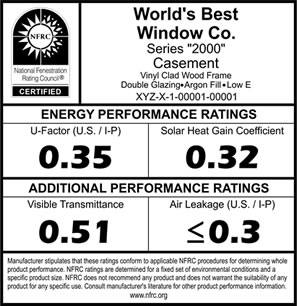NFRC labels provide ratings for U-factor and Solar Heat Gain Coefficient, and Visible Transmittance, information is included on testing for Air Leakage and Condensation Resistance.
U-factor
U-factor measures how well a product stops heat from escaping a home. U-factor ratings commonly fall between 0.15 and 1.20. The lower the U-factor, the better a product is at keeping heat inside the building. U-factor is particularly important during the winter heating season in colder climates. This label shows the U-factor in U.S. units.
What’s the Difference between U-factor and R-value?
The biggest difference between U-factor and R-value is that U-factor measures the rate of heat transmission (or loss) while R-value measures the resistance to heat loss. R-value is a measure of conductance and resistance. A product with high conductance will conduct heat quickly, like a hot pan on the stove. U-factor, on the other hand, takes into consideration more than conductance. It also is affected by the airflow around the window and the emissivity (radiated or reflected heat) of the glass.
Sourced here

